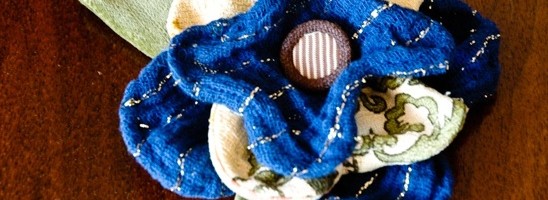Blue Blazin’ Bag
I have an addiction named ‘coffee’.
I have a problem named ‘clumsiness’.
Eventually, my favorite beverage and my butterfingers collide, causing devastation to my beloved apparel. After many such occurrences, I salvage the usable material to give it a second life.

I made a lovely bag out of a coffee-stained corduroy blazer; using a moth-eaten sweater for the lining. There are several steps involved to making this, but overall it was pretty dang easy.
The two outside pockets hold my most important essentials-my cell phone in one, gum and chapstick in the other. The bag is big enough to fit my computer and my other what-not’s, as well.

Here’s what you’ll need to make your very own Blazin’ Bag:
A (coffee stained) blazer
A (moth eaten) sweater about the same width as your blazer
Thread to match
Seam ripper
Tape Measure
Straight Pins
Scissors
Iron & Ironing board
Sewing Machine with heavy duty needle

First, cut the sleeves and the collar from your blazer.

Sew the opening of your blazer closed (down the front of the original blazer). Take a moment to sip a cup of coffee…but be careful. No spilling allowed.

Cut the top of the blazer off, right where the sleeves would have been sewn onto the rest of the jacket.

Measure the width of the bottom of the blazer. My blazer was 17” wide at the bottom. Measure the same amount from the cut opened sleeve, plus one more inch for seam allowance on either side. The sleeve will add additional inches to the length of your bag. You don’t have to add the sleeve if you feel the body of your bag is large enough, as is.

Turn both the sleeve and the blazer inside out. Pin one side of the sleeve to the front of the blazer and the other side of the sleeve to the back of the blazer. Sew the sleeve to the bottom of the blazer. Sew the ends of the sleeve closed and attach them to the side of your blazer.

This is what the bag looks like at this point, right side out, if you didn’t accidentally sew the bottom of your bag closed.

Cut the sleeves and any ribbing along the bottom of the sweater and then turn it inside out. Also, turn your blazer bag inside out. My sweater was about the same width as my blazer bag. If your sweater is much larger, sew a seam and remove any excess. The sweater will be the lining to your bag.

With wrong sides together, pin the sweater to the top of the blazer bag, and sew together the two about a 1/4” down from the top.

Turn your bag right side out and fold the blazer inside the bag one inch from the top-iron flat.

Sew a seam 1/4” down from the top of the bag around the entire opening of the bag.

Turn the bag inside out, and sew the bottom of your sweater closed, leaving a 4” wide opening. Pull the bag back through the 4″ opening. Fold the opening under and sew closed once the bag is right side out.

With the leftover parts from the blazer and the sweater, piece together two 2 1/2” wide strips that are 2’ long. Iron a 1/4” seam allowance on each side. These will be the straps to your bag.

Pin the sweater to the blazer, wrong sides together. Sew the two together from the right side.

Decide where you would like the straps to be on your bag. Fold under the unfinished ends of the straps and sew them to the inside of your bag, using the ‘x’ formation for added strength.

Now, take your blazer bag out on the town-show it a good time and fill it with paraphernalia from your local pumpkin farm.
Or not. Your choice.



















































